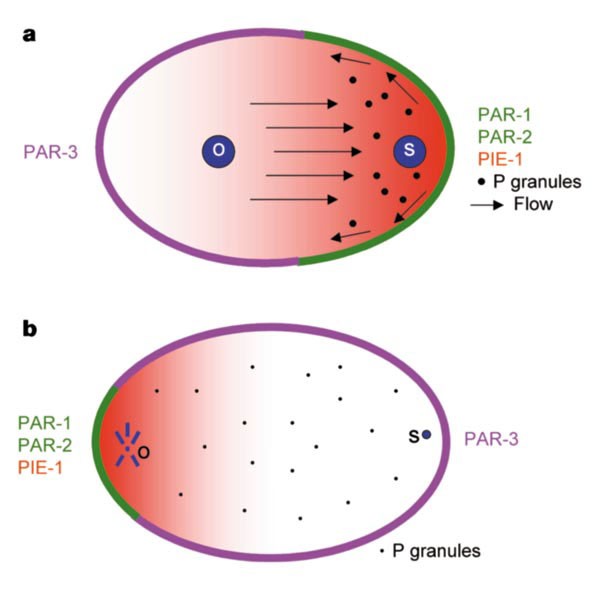
- Select a language for the TTS:
- UK English Female
- UK English Male
- US English Female
- US English Male
- Australian Female
- Australian Male
- Language selected: (auto detect) - EN
Play all audios:
ABSTRACT In _Caenorhabditis elegans_, polarity along the anterior–posterior (A/P) axis is established shortly after fertilization and is determined by the sperm, whose position specifies the
posterior end of the embryo1. Although many factors required for the establishment of A/P polarity have been described2,3, the nature of the spatial cue provided by the sperm remains
unknown. Here we show that a microtubule-organizing centre is necessary and sufficient to establish several aspects of A/P polarity. In wild-type embryos, appearance of the first molecular
asymmetries along the A/P axis correlates with and requires nucleation of microtubules by the sperm-derived centrosomes (sperm asters). In mutant embryos arrested in meiosis, sperm asters
fail to form, and posterior is defined by the position of the persistent meiotic spindle rather than by the position of the sperm. Together, our data indicate that the primary spatial cue
for A/P polarity in _C. elegans _ derives from microtubules emanating from the sperm asters. Our findings support a parallel4,5,6,7 between _C. elegans_ zygotes and other cells, such as
_Drosophila_ oocytes, which rely on microtubules to regulate polarity. Access through your institution Buy or subscribe This is a preview of subscription content, access via your institution
ACCESS OPTIONS Access through your institution Subscribe to this journal Receive 51 print issues and online access $199.00 per year only $3.90 per issue Learn more Buy this article *
Purchase on SpringerLink * Instant access to full article PDF Buy now Prices may be subject to local taxes which are calculated during checkout ADDITIONAL ACCESS OPTIONS: * Log in * Learn
about institutional subscriptions * Read our FAQs * Contact customer support SIMILAR CONTENT BEING VIEWED BY OTHERS ASYMMETRY IN CENTROSOME MATURATION REVEALED THROUGH AIR-1 DYNAMICS IN THE
EARLY _CAENORHABDITIS ELEGANS_ EMBRYO Article Open access 13 March 2025 ELONGATOR STABILIZES MICROTUBULES TO CONTROL CENTRAL SPINDLE ASYMMETRY AND POLARIZED TRAFFICKING OF CELL FATE
DETERMINANTS Article 27 October 2022 RAN-GTP ASSEMBLES A SPECIALIZED SPINDLE STRUCTURE FOR ACCURATE CHROMOSOME SEGREGATION IN MEDAKA EARLY EMBRYOS Article Open access 01 February 2024
REFERENCES * Goldstein, B. & Hird, S. N. Specification of the anteroposterior axis in _Caenorhabditis elegans_. _Development_ 122, 1467–1474 (1996). CAS PubMed Google Scholar * Rose,
L. S. & Kemphues, K. J. Early patterning of the _ C. elegans_ embryo. _Annu. Rev. Genet._ 32, 521–545 (1998). Article CAS Google Scholar * Bowerman, B. Maternal control of pattern
formation in early _Caenorhabditis elegans_ embryos. _Curr. Top. Dev. Biol._ 39, 73– 117 (1998). Article CAS Google Scholar * Shulman, J. M., Benton, R. & St Johnston, D. The
_Drosophila_ homolog of _C. elegans_ PAR-1 organizes the oocyte cytoskeleton and directs oskar mRNA localization to the posterior pole. _Cell_ 101, 377– 388 (2000). Article CAS Google
Scholar * Tomancak, P. _ et al._ A _Drosophila melanogaster_ homologue of _Caenorhabditis elegans_ par-1 acts at an early step in embryonic-axis formation. _ Nature Cell Biol._ 2, 458–460
(2000). Article CAS Google Scholar * Kemphues, K. PARsing embryonic polarity. _Cell_ 101, 345 –348 (2000). Article CAS Google Scholar * Morris, J., Lehmann, R. & Navarro, C.
PARallels in axis formation. _Science_ 288, 1759–1760 (2000). Article CAS Google Scholar * Hird, S. N. & White, J. G. Cortical and cytoplasmic flow polarity in early embryonic cells
of _Caenorhabditis elegans_. _J. Cell Biol._ 121, 1343–1355 ( 1993). Article CAS Google Scholar * Hird, S. N., Paulsen, J. E. & Strome, S. Segregation of germ granules in living
_Caenorhabditis elegans_ embryos: cell-type-specific mechanisms for cytoplasmic localisation. _Development_ 122, 1303– 1312 (1996). CAS PubMed Google Scholar * Sadler, P. L. & Shakes,
D. C. Anucleate _Caenorhabditis elegans _ sperm can crawl, fertilize oocytes and direct anterior-posterior polarization of the 1-cell embryo. _Development_ 127, 355 –366 (2000). CAS PubMed
Google Scholar * Furuta, T. _ et al._ EMB-30: An APC4 homologue required for metaphase-to-anaphase transitions during meiosis and mitosis in _Caenorhabditis elegans_. _ Mol. Biol. Cell_
11, 1401–1419 (2000). Article CAS Google Scholar * Etemad-Moghadam, B., Guo, S. & Kemphues, K. J. Asymmetrically distributed PAR-3 protein contributes to cell polarity and spindle
alignment in early _C. elegans_ embryos. _Cell_ 83, 743–752 (1995). Article CAS Google Scholar * Tenenhaus, C., Schubert, C. & Seydoux, G. Genetic requirements for PIE-1 localization
and inhibition of gene expression in the embryonic germ lineage of _Caenorhabditis elegans _. _Dev. Biol._ 200, 212– 224 (1998). Article CAS Google Scholar * Boxem, M., Srinivasan, D. G.
& van den Heuvel, S. The _Caenorhabditis elegans_ gene ncc-1 encodes a cdc2-related kinase required for M phase in meiotic and mitotic cell divisions, but not for S phase. _Development_
126 , 2227–2239 (1999). CAS PubMed Google Scholar * Albertson, D. G. Formation of the first cleavage spindle in nematode embryos. _Dev. Biol._ 101, 61–72 ( 1984). Article CAS Google
Scholar * Boyd, L., Guo, S., Levitan, D., Stinchcomb, D. T. & Kemphues, K. J. PAR-2 is asymmetrically distributed and promotes association of P granules and PAR-1 with the cortex in _C.
elegans_ embryos. _Development_ 122, 3075– 3084 (1996). CAS PubMed Google Scholar * Strome, S. & Wood, W. B. Generation of asymmetry and segregation of germ-line granules in early
_C. elegans_ embryos. _ Cell_ 35, 15–25 ( 1983). Article CAS Google Scholar * Schumacher, J. M., Ashcroft, N., Donovan, P. J. & Golden, A. A highly conserved centrosomal kinase,
AIR-1, is required for accurate cell cycle progression and segregation of developmental factors in _Caenorhabditis elegans_ embryos. _Development_ 125, 4391 –4402 (1998). CAS PubMed Google
Scholar * O'Connell, K., Maxwell, K. & White, J. The spd-2 gene is required for polarization of the anteroposterior axis and formation of the sperm asters in the _Caenorhabditis
elegans_ zygote. _Dev. Biol._ 221, 55– 70 (2000). Article Google Scholar * Hill, D. P. & Strome, S. Brief cytochalasin-induced disruption of microfilaments druing a critical interval
in one-cell _C. elegans_ embryos alters the partitioning of developmental instructions to the two-cell embryo. _Development_ 108, 159– 172 (1990). CAS PubMed Google Scholar * Shelton, C.
A., Carter, J. C., Ellis, G. C. & Bowerman, B. The nonmuscle myosin regulatory light chain gene mlc-4 is required for cytokinesis, anterior-posterior polarity, and body morphology during
_Caenorhabditis elegans_ embryogenesis. _J. Cell Biol._ 146, 439–451 (1999). Article CAS Google Scholar * van Eeden, F. & St Johnston, D. The polarisation of the anterior-posterior
and dorsal-ventral axes during _Drosophila_ oogenesis. _Curr. Opin. Genet. Dev._ 9, 396–404 (1999). Article CAS Google Scholar * Bohm, H., Brinkmann, V., Drab, M., Henske, A. &
Kurzchalia, T. V. Mammalian homologues of _C. elegans_ PAR-1 are asymmetrically localized in epithelial cells and may influence their polarity. _Curr. Biol._ 7, 603–606 (1997). Article CAS
Google Scholar * Drewes, G., Ebneth, A., Preuss, U., Mandelkow, E. M. & Mandelkow, E. MARK, a novel family of protein kinases that phosphorylate microtubule-associated proteins and
trigger microtubule disruption. _ Cell_ 89, 297–308 ( 1997). Article CAS Google Scholar * Reese, K. J., Dunn, M. A., Waddle, J. A. & Seydoux, G. Asymmetric segregation of PIE-1 in _C.
elegans_ is mediated by two complementary mechanisms that act through separate PIE-1 protein domains. _Mol. Cell. _ 6, 445–455 ( 2000). Article CAS Google Scholar * Guo, S. &
Kemphues, K. J. par-1, a gene required for establishing polarity in _C. elegans_ embryos, encodes a putative Ser/Thr kinase that is asymmetrically distributed. _Cell_ 81, 611–620 (1995).
Article CAS Google Scholar * Strome, S. & Wood, W. B. Immunofluorescence visualization of germ-line-specific cytoplasmic granules in embryos, larvae, and adults of _Caenorhabditis
elegans_. _Proc. Natl Acad. Sci. USA_ 79, 1558–1562 (1982). Article ADS CAS Google Scholar * Timmons, L. & Fire, A. Specific interference by ingested dsRNA. _Nature_ 395, 854 (
1998). Article ADS CAS Google Scholar * Edgar, L. G. Blastomere culture and analysis. _Methods Cell Biol._ 48, 303–321 (1995). Article CAS Google Scholar * McCarter, J., Bartlett, B.,
Dang, T. & Schedl, T. On the control of oocyte meiotic maturation and ovulation in _Caenorhabditis elegans_. _Dev. Biol._ 205, 111–128 (1999). Article CAS Google Scholar Download
references ACKNOWLEDGEMENTS We are grateful to A. Golden, P. Sadler, J. Schumacher and D. Shakes for their characterization of the _mat_ mutants. We also thank K. O'Connell and J. White
for sharing results before publication; K. Kemphues and L. Boyd for antibodies; L. Timmons and A. Fire for RNAi feeding materials; and A. Golden, P. Sadler, D. Shakes, K. Kemphues, K.
O'Connell, Y. Zheng and members of the Seydoux lab for comments on the manuscript. Some strains used in this study were provided by the Caenorhabditis Genetics Center (University of
Minnesota). M.R.W. was an NSF predoctoral fellow. This work was supported by grants from the Searle and Packard Foundations to G.S. AUTHOR INFORMATION AUTHORS AND AFFILIATIONS * Department
of Molecular Biology and Genetics, Johns Hopkins University School of Medicine, Baltimore, 21205 , Maryland, USA Matthew R. Wallenfang & Geraldine Seydoux Authors * Matthew R. Wallenfang
View author publications You can also search for this author inPubMed Google Scholar * Geraldine Seydoux View author publications You can also search for this author inPubMed Google Scholar
CORRESPONDING AUTHOR Correspondence to Geraldine Seydoux. RIGHTS AND PERMISSIONS Reprints and permissions ABOUT THIS ARTICLE CITE THIS ARTICLE Wallenfang, M., Seydoux, G. Polarization of
the anterior–posterior axis of _C. elegans_ is a microtubule-directed process. _Nature_ 408, 89–92 (2000). https://doi.org/10.1038/35040562 Download citation * Received: 10 May 2000 *
Accepted: 16 August 2000 * Issue Date: 02 November 2000 * DOI: https://doi.org/10.1038/35040562 SHARE THIS ARTICLE Anyone you share the following link with will be able to read this content:
Get shareable link Sorry, a shareable link is not currently available for this article. Copy to clipboard Provided by the Springer Nature SharedIt content-sharing initiative





![[Withdrawn] PO17 6BU, Mr Robin Culverhouse: environmental permit application advertisement - GOV.UK](https://www.gov.uk/assets/static/govuk-opengraph-image-03837e1cec82f217cf32514635a13c879b8c400ae3b1c207c5744411658c7635.png)